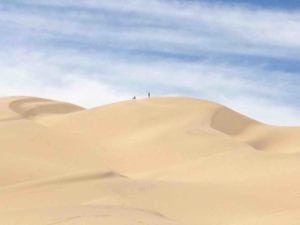The word Gobi means large and dry in the Mongolian language. The world’s fifth largest desert spans 0.5 million square miles of northern China and southern Mongolia. It’s a place of intrigue, fascinating history, and a diversity of wildlife.

Riders on the Gobi Discovery tour glimpse its wild, unpredictable, and stunning character.
Gobi Desert’s Rich History
- Annual rainfall is about seven inches. Its location in the rain shadow of the Himalayan and connecting ranges gives rise to its aridity.
- Elevations of its basins range from approximately 1600 to 5000’ (488 to 1524m) above sea level.
- Only five percent of the Gobi is covered in sand dunes. Most of the terrain is firm and rocky, with gravel and sparse vegetation. The most popular scientific theory states wind currents carried sands into the desert. An alternative idea claims the dunes were a product of water erosion.
- The climate is extreme, with rapid seasonal and daily temperature swings. Summer heat can reach 50°C. In winter, temperatures can plummet below -40°C. With nothing to stop it, wind-chill can add significantly to that.
- In contrast to the image of an endless, flat, mundane desert, the Gobi has five distinct biospheres:
- Eastern Gobi desert steppe. Characterized by salt marshes and small ponds in the lower elevations. These disappear as the elevation rises to become the Yin Shan Mountain Range. Basins also support drought-adapted plant life and thin patches of wild grass.
- Alashan plateau semi-desert. Consists of desert basins and low mountains. It lies between the Altay range, Helan Mountains, Qilian Mountains, and Tibetan Plateau.
- Junggar or Dzungarian Basin semi-desert. It includes the basin lying between the Altay mountains on the north and the Tian Shan range in the south.
- Gobi Lakes Valley desert steppe. This region supports a thriving aquatic community of marine animals and plant forms. The lakes also provide a valuable habitat for birds.
- Tian Shan (or Celestial) range. A low, sandy desert basin, it’s surrounded by the high ranges of the Tibetan Plateau and the Pamirs. Some of the world’s first fossilized dinosaur eggs were discovered here.
- The Silk Road, used by traders, including Marco Polo, passes through the Gobi. A few important cities existed for traders to stop and rest on their trek from Europe to China.
- The ruins of Karakorum (Kharakhorum or Khara Khorum) lie near today’s town of Kharkhorin. In the 13th C the palace was the heart of the Mongol Empire, surrounded by arable land and rich mineral deposits.
- Erdene Zuu, the most ancient Buddhist monastery in Mongolia, sits next to Kharkhorin. Constructed in 1585, it has withstood damaging assaults over the centuries. It remains an active Buddhist monastery as well as a museum that is open to tourists.
- The Gobi bear, among the rarest and least known large mammals on earth, lives here. A member of the species Ursus arctos, commonly known as the brown bear or grizzly, no more than two or three dozen survive. None live in captivity. Although this mysterious animal was known by the people of Mongolia, it was only in 1943 that a sighting by a Russian scientist-explorer confirmed its existence.
- Endangered species such as the wild Bactrian camel, snow leopard, takhi (domestic and wild horses), and the world’s largest herds of Asiatic wild asses call the Gobi home. Other animals survive in this parched landscape, defying the odds. Foxes, wolves, lynx, gazelles, Argali sheep and ibex roam hills and scale canyon cliffs.
- The Gobi desert is growing rapidly, devouring valuable grassland in China. The biggest culprit is overgrazing by cashmere goats because of the demand for their wool.
- Boom times threaten the pristine desert. Nearly a third of the nation’s income may soon come from copper and gold mines beneath its surface. There’s also a massive coal mine, possibly the largest in the world, under development.
Read about our Gobi Discovery Tour.
Photo Credits: Piet Human
Sources:
- New World Encyclopedia
- National Geographic
- Gobi Desert Org
- Desert USA
- Wikipedia—Wildlife of Mongolia

